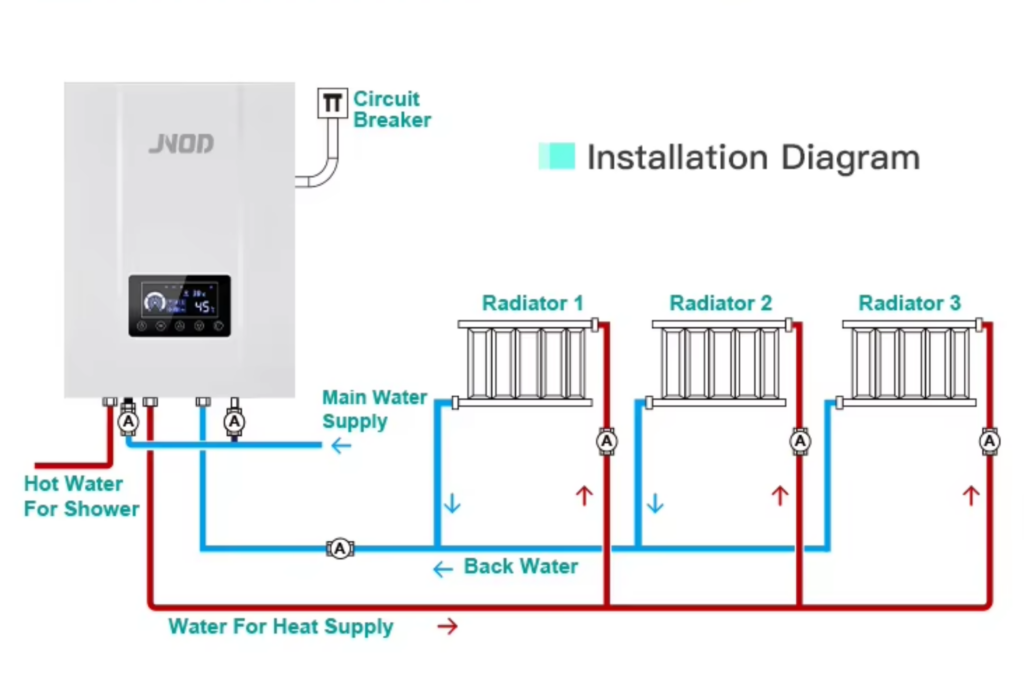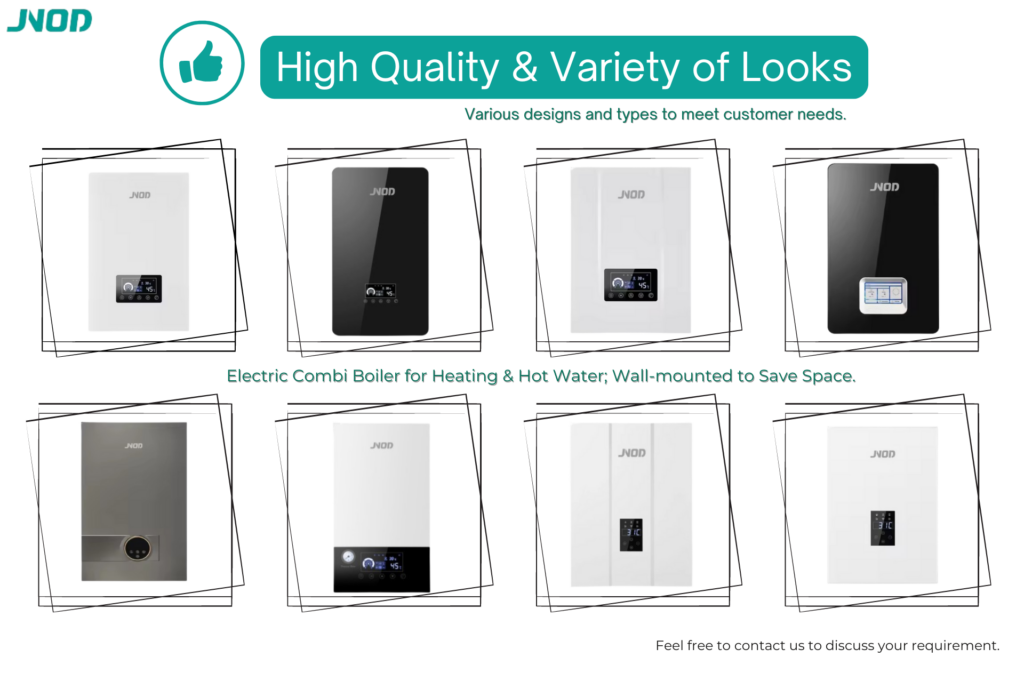From Cold to Cozy: A Beginner's Journey Through Electric Combi Boilers
Table of Contents
People aways tend to look for more energy-efficient and space-saving solutions for home heating. Electric combi boilers have become a popular choice because they have dual heating systems and compact designs.
In this guide, we’ll introduce to you what a combi electric boiler is, how it works, its features and applications, and more. We’ll explore answers to your questions and provide practical tips. By the end of this journey, you’ll have a better understanding of combi boilers and will be able to make an informed and confident decision about the options for your home heating and hot water needs.
What is an Electric Combi Boiler?
A Electric combi Boiler is a boiler that provides both central heating and hot water on demand, without the need for a separate water tank. A combination electric boiler heats more efficiently and faster because it has two heat sources that can work together to increase heating capacity. Usually, it’s considered eco-friendly because it doesn’t use fuel but electricity to generate heat with no carbon emissions. It is very suitable for apartments and small-sized homes.
How the Electric combi boiler works?
The principle of operation is simple – it uses electricity to heat water which is then circulated for domestic hot water (DHW) and central heating. Below are the roles of the various working elements:
- Heating element: it is the core component that heats the water. It utilizes electrical resistance to generate heat.
- Heat exchanger: transfers heat from the heating element to the water efficiently.
- Expansion vessel: when the water heats up expansion can come here, preventing excessive pressure.
- Pumps: circulate hot water between the central heating system (radiators or underfloor heating system) and domestic hot water taps.
- Control system: controls the boiler’s operation, temperature and ensures efficient performance. It includes the thermostat and safety controls.
- Pressure relief valve: ensures safety by releasing water if the pressure exceeds a safe level.
- Flow switch: when the hot water tap is opened, it sends a signal to the boiler to start heating.
Heating Mode
When the thermostat detects that the room temperature has reached the set temperature, it sends a start signal to the Electric combi boiler. An electric heating element is energized to heat the water in the boiler. A pump circulates the hot water through the central heating system, heating radiators or underfloor heating systems throughout the home. The thermostat constantly monitors the room temperature, cycling the boiler on and off to maintain a constant temperature.
Domestic Hot Water Mode
The flow switch will detect the flow of water when the hot water tap is opened. The Electric combi boiler prioritizes hot water demand and uses an electric heating element to heat the water almost instantly. The heated water flows into the faucet and provides hot water on demand, so there is no need for a storage tank.

Electric Combi Boiler Features
1. Compact design: As it does not require a water tank, an electric combi boiler requires less space than a classical system, making it suitable for smaller homes or apartments.
2. Easy to install: Due to its compactness and the lack of an additional water tank, an electric combi boiler is easier and faster to install.
3. Pressure and flow: The water pressure of a combi boiler is usually the same as the tap water pressure, which leads to a better water flow compared to conventional systems.
4. Continuous hot water supply: combi boilers heat water directly from the mains when in use. This means you can get hot water on demand, which is very convenient.
5. Quiet operation: Because the pump is the only moving part.
6. Energy efficiency: It runs at almost 100% efficiency. Combination boilers are often more energy efficient than classical systems because they only heat the water you need. This reduces wasted energy and can lower utility bills.
Advantages of JNOD Electric Combi Boilers
1. With weather compensation function to provide a comfortable temperature.
2. Separation system of water and electricity to increase the safety factor.
3. Unique patented heating element to improve electric boiler efficiency.
4. Multiple appearance options to choose from, LED or Touch screen.
5. Maximum water temperature 85°C, 30°C~80°C (radiator mode), 30°C~60°C (underfloor heating mode).
6. Anti-freezing and sterilizing function.
7. Double dry heat protection and PV ready function.
8. Wide range of size options:13-26kw, both single-phase and three-phase to meet the needs of different families.
9. Wall-mounted type, more space-saving.
10. Built-in fault-finding diagnostic function, which can quickly troubleshoot.
Consideration
Water Flow: Combination boilers can sometimes have trouble providing a strong water flow if multiple outlets are used at the same time. Larger sizes may be required for larger families with higher hot water demands.
System type suitability: while combi boilers are ideal for smaller properties, they may not be the best choice for homes with high hot water usage or where hot water is required from multiple taps at the same time.
Cost: While combi boilers are easy to install and maintain, the high cost of electricity can lead to higher running costs. In terms of future trends, electricity prices will gradually decrease.

How to choose the right size?
Choosing the right size for a combi electric boiler is essential to ensure efficient heating and hot water supply without wasting energy. Please note that here sizing does not refer to the physical appearance of the boiler, but to the heat produced, with ratings expressed in kilowatts (kW).
Know your Heating and Hot Water Needs
Size of the house: the larger the area, the higher the heating needs
Number of rooms: More rooms usually means a higher capacity boiler.
Number of radiators: Each radiator increases the boiler size by approximately 1.5 kW
Number of bathrooms: The more bathrooms, the higher the demand for hot water.
Number of hot water outlets: consider the number of appliances that use hot water, such as washing machines, dishwashers and showers.
Rough Guide and Examples
10 kW: for small houses or apartments of 100 square meters and 2 bathrooms.
24-27 kW: for small houses or apartments with up to 10 radiators and 1 bathroom.
Choosing the right size electric combi boiler requires confirming your home’s heating and hot water needs and calculating the required output in kilowatts. It is recommended to consult a professional or sales expert for an accurate assessment to ensure optimal performance and efficiency.
Get Started Today: Contact Us for More Information
From understanding what it is to how to choose the right size, this whole article is very comprehensive. In our next post, we may write a separate article on choosing the right size boiler. Electric combi boilers offer a convenient and efficient solution for heating and hot water needs, making them a popular choice for many homes.
